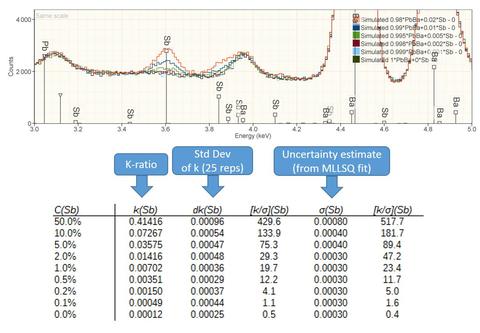Forensic Trace Evidence

Figure from Quantitative Metrics for GSR
Inorganic Gunshot Residue (GSR) is a widely used forensic tool for determining whether an individual was present when a gun was discharged. When a gun discharges, the gunpowder is usually initiated by the primer containing the elements lead, barium and antimony. The heat of the discharge forms micron-scale particles containing these elements which exit the gun and come to rest on nearby surfaces. An individual who has recently discharged a gun or been close to a discharging gun is likely to have GSR particles on their skin, hair and clothing. Likewise, objects in proximity to a discharging gun are also likely have GSR particles adhered to their surface. These particles can be extracted from these surfaces using a sticky carbon tape. Scanning electron microscopes with energy dispersive X-ray spectrometers (SEM/EDX) are used to search the carbon tape for GSR particles. Usually the search is performed using automated algorithms which take control of the SEM/EDX and by performing image analysis and spectral analysis can search the area of the carbon tape quickly and effectively for GSR particles. Candidate GSR particles are later confirmed by manual reexamination of the images and spectra.
While GSR is an established technique, there remain many valid concerns about the unbiased application of the technique. For example, when candidate GSR particles are manually reconfirmed, the manual reconfirmation is performed by examining the X-ray spectrum by eye for X-ray lines characteristic of the elements lead, barium and antimony. While an expert examiner is likely to be able to correctly identify these lines, there are many other combinations of elements which can produce similar albeit not identical spectral signatures. There is a trained skill involved in correctly identifying these elements and other confounding elements which may enhance or detract from the evidentiary value of the sample.
There is a better way. By using long-established techniques within the quantitative SEM/EDX community to fit “standard spectra” to the candidate spectra, it is possible to place quantitative metrics on the presence or absence of elements. The metrics can suggest not only the presence or absence of an element but also the strength of the evidence for an element. So rather than the expert saying “in my expert opinion this element is present”, the quantitative method might provide the more defensible statement that “the spectral data suggest that there is a 99.99% chance that the element is present.” Likewise, when an element does not appear to be present the statement that “the element was not seen with a limit-of-detection of 0.001” is a far stronger statement than “in my expert opinion the element is not present.” Furthermore, quantitative metrics take much of the opportunity for bias out of the measurement process. If the community were to say that to deem an element present required a quantitatively defensible 99% level-of-confidence, then this would eliminate the chance of analysts seeing signal-in-the-noise to “make it positive.” NIST sees its role as a metrological institute to encourage communities such as the GSR community to apply the best algorithms to make the best use of the data available. It is going to require a change of mindset and toolset within the community to make these changes. We are developing tools that will facilitate this change and working directly with practitioners to convince them of the necessity.
Facilities
Building 217 Lab F101
Customers/Contributors/Collaborators
OSAC, Gunshot Residue Committee
Contacts
Staff
-
(301) 975-3929

